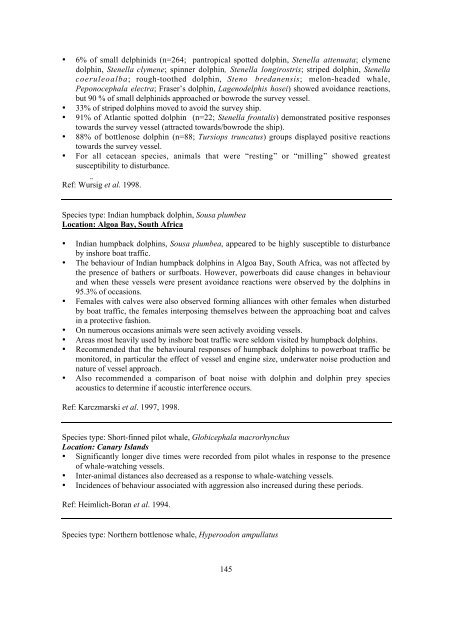Oceans of noise - Whale and Dolphin Conservation Society
Oceans of noise - Whale and Dolphin Conservation Society
Oceans of noise - Whale and Dolphin Conservation Society
- No tags were found...
Create successful ePaper yourself
Turn your PDF publications into a flip-book with our unique Google optimized e-Paper software.
• 6% <strong>of</strong> small delphinids (n=264; pantropical spotted dolphin, Stenella attenuata; clymenedolphin, Stenella clymene; spinner dolphin, Stenella longirostris; striped dolphin, Stenellacoeruleoalba; rough-toothed dolphin, Steno bredanensis; melon-headed whale,Peponocephala electra; Fraser’s dolphin, Lagenodelphis hosei) showed avoidance reactions,but 90 % <strong>of</strong> small delphinids approached or bowrode the survey vessel.• 33% <strong>of</strong> striped dolphins moved to avoid the survey ship.• 91% <strong>of</strong> Atlantic spotted dolphin (n=22; Stenella frontalis) demonstrated positive responsestowards the survey vessel (attracted towards/bowrode the ship).• 88% <strong>of</strong> bottlenose dolphin (n=88; Tursiops truncatus) groups displayed positive reactionstowards the survey vessel.• For all cetacean species, animals that were “resting” or “milling” showed greatestsusceptibility to disturbance.Ref: Würsig et al. 1998.Species type: Indian humpback dolphin, Sousa plumbeaLocation: Algoa Bay, South Africa• Indian humpback dolphins, Sousa plumbea, appeared to be highly susceptible to disturbanceby inshore boat traffic.• The behaviour <strong>of</strong> Indian humpback dolphins in Algoa Bay, South Africa, was not affected bythe presence <strong>of</strong> bathers or surfboats. However, powerboats did cause changes in behaviour<strong>and</strong> when these vessels were present avoidance reactions were observed by the dolphins in95.3% <strong>of</strong> occasions.• Females with calves were also observed forming alliances with other females when disturbedby boat traffic, the females interposing themselves between the approaching boat <strong>and</strong> calvesin a protective fashion.• On numerous occasions animals were seen actively avoiding vessels.• Areas most heavily used by inshore boat traffic were seldom visited by humpback dolphins.• Recommended that the behavioural responses <strong>of</strong> humpback dolphins to powerboat traffic bemonitored, in particular the effect <strong>of</strong> vessel <strong>and</strong> engine size, underwater <strong>noise</strong> production <strong>and</strong>nature <strong>of</strong> vessel approach.• Also recommended a comparison <strong>of</strong> boat <strong>noise</strong> with dolphin <strong>and</strong> dolphin prey speciesacoustics to determine if acoustic interference occurs.Ref: Karczmarski et al. 1997, 1998.Species type: Short-finned pilot whale, Globicephala macrorhynchusLocation: Canary Isl<strong>and</strong>s• Significantly longer dive times were recorded from pilot whales in response to the presence<strong>of</strong> whale-watching vessels.• Inter-animal distances also decreased as a response to whale-watching vessels.• Incidences <strong>of</strong> behaviour associated with aggression also increased during these periods.Ref: Heimlich-Boran et al. 1994.Species type: Northern bottlenose whale, Hyperoodon ampullatus145




